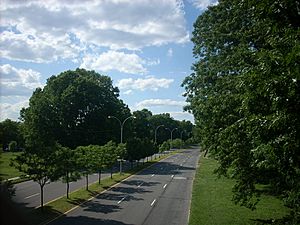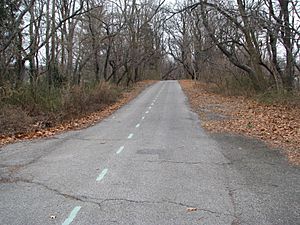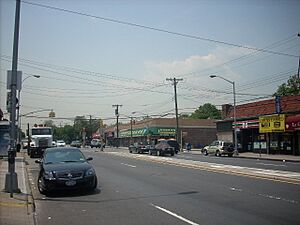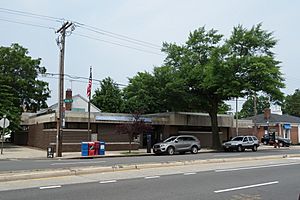Fresh Meadows, Queens facts for kids
Quick facts for kids
Fresh Meadows
|
|
|---|---|
|
Neighborhood of Queens
|
|
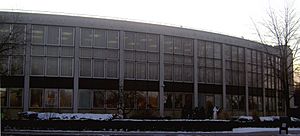
St. Francis Preparatory School
|
|
| Country | |
| State | |
| City | New York City |
| County/Borough | Queens |
| Community District | Queens 8 |
| Population | |
| • Estimate
(2010)
|
17,812 |
| Based on 2010 U.S. Census figures; excludes Hillcrest | |
| Ethnicity | |
| • Asian | 47.1% |
| • White | 32.9% |
| • Hispanic | 9.9% |
| • Black | 7.6% |
| • Other/Multiracial | 2.5% |
| Economics | |
| • Median income | ,005 |
| Time zone | UTC−5 (EST) |
| • Summer (DST) | UTC−4 (EDT) |
| ZIP Codes |
11365, 11366
|
| Area codes | 718, 347, 929, and 917 |
Fresh Meadows is a neighborhood in the northeastern part of Queens, a borough of New York City. It used to be part of the larger town of Flushing.
Fresh Meadows is bordered by the Horace Harding Expressway and Auburndale to the north. To the west, you'll find Pomonok, St. John's University, Hillcrest, and Utopia. Cunningham Park and the Clearview Expressway are to the east. The Grand Central Parkway forms its southern border.
This neighborhood is part of Queens Community Board 8. Its main ZIP Codes are 11365 and 11366. The New York City Police Department's 107th Precinct keeps the area safe. Fresh Meadows is represented by the 23rd and 24th Districts of the New York City Council.
Contents
History of Fresh Meadows
The name "Fresh Meadows" has been around since before the American Revolution. The area was once part of Flushing, which had many salt marshes. However, the wetlands in this hilly area were fed by freshwater springs, making them "fresh meadows."
A road called Fresh Meadows Road ran through the area. Today, parts of it are known as Fresh Meadows Lane and Utopia Parkway. This road connected Whitestone Landing to the village of Jamaica.
Revolutionary War and Black Stump Road
During the American Revolution, British soldiers camped in the area. General Benedict Arnold even trained his troops where M.S. 216 is today. To help move military supplies, a new road was built. It connected Fresh Meadows Road with Hempstead.
This new road started near what is now Utopia Parkway and 73rd Avenue. There was a famous local landmark nearby: a large tree stump that had burned after being hit by lightning. It was known as the "Black Stump." The new road was named "Black Stump Road" after this landmark.
In the 1800s, a farming community called Black Stump grew in the area. The Black Stump School was located where Utopia Playground is now. For a few years, people thought the woods of Black Stump were haunted because of strange sounds. In 1908, it was discovered that the sounds came from a man who lived in a small hut and sang Irish folk songs at night.
Fresh Meadow Country Club
The Fresh Meadow Country Club opened in 1923. It was named after an area northeast of Flushing, even though it was actually southeast of Flushing. The golf course was designed by A.W. Tillinghast.
This club hosted major golf tournaments:
- The PGA Championship in 1930.
- The U.S. Open in 1932.
In 1937, a special charity golf game took place here. Famous athletes like Babe Ruth and Babe Didrikson played. About 10,000 fans watched this exciting game.
Fresh Meadows Housing Development
In 1946, the land where the country club was located was sold to the New York Life Insurance Company. They built the Fresh Meadows Housing Development there. This complex was designed to house local World War II veterans. It was one of the first places in the U.S. built mainly for cars, not just people walking. In 1949, a city planner named Lewis Mumford called it a great example of community planning.
Until 2004, Klein Farm was the last working farm in New York City. It was located on 73rd Avenue. People are working to reopen the farm today.
In 2011, a book about the history of Fresh Meadows was released. Today, the area has Cunningham Park. The Long Island Motor Parkway, which used to be a highway, is now a biking and walking trail. It is part of the Brooklyn–Queens Greenway.
Neighborhood Sections
Fresh Meadows includes smaller areas known as Hillcrest and Utopia.
Hillcrest
Hillcrest is a neighborhood in the center of Queens. Its name comes from its location on the hills between Flushing and Jamaica. Hillcrest stretches from the Grand Central Parkway to 73rd Avenue. It is located between Utopia Parkway and Parsons Boulevard.
Its main shopping street is Union Turnpike. Hillcrest is part of Queens Community Board 8. Most of Hillcrest has single-family homes. It is known for good public schools and a low crime rate.
History of Hillcrest
In 1938 and 1939, Moss Brothers built about 550 homes in Hillcrest. These homes were along Utopia Parkway. The development was called Hillcrest Gardens.
Utopia
Utopia is in the southeastern part of Fresh Meadows. It is bordered by Utopia Parkway to the west and 73rd Avenue to the north. 188th Street is to the east, and Union Turnpike is to the south.
Utopia is part of Queens Community Board 8. Many people consider it part of Fresh Meadows. Utopia has many Conservative and Orthodox Jews, Chinese Americans, Korean Americans, Russian Americans, Indian Americans, and Hispanic and Latino Americans. It mainly has houses and streets lined with trees.
Utopia Playground is a triangular park at Utopia Parkway and 73rd Avenue. This used to be the site of the Black Stump School. Today, it has a playground, a softball field, and basketball courts.
Utopia is next to Hillcrest to the west and Fresh Meadows to the north and east. Jamaica Estates is to the south. The Hillcrest Jewish Center and the Queens Public Library at Hillcrest are both located in Utopia.
History of Utopia
In 1903, the Utopia Land Company was formed. The next year, they bought land to create a community for Jewish families. They wanted to help families move away from the Lower East Side of Manhattan.
The company planned to name the streets after those in the Lower East Side. However, they could not get enough money to build the community. In 1909, much of the land was sold.
The area remained farmland until 1935. Then, the Gross-Morton Park Corporation bought the land. This company had experience building homes in Queens. In the early 1940s, they built colonial and Cape Cod-style homes in Utopia. These homes had two or three bedrooms.
Population and People
In 2010, the population of Fresh Meadows (including Utopia but not Hillcrest) was 17,812 people. The neighborhood covers about 636 acres.
The people living in Fresh Meadows come from many different backgrounds:
- 47.1% Asian
- 32.9% White
- 9.9% Hispanic
- 7.6% Black
- 2.5% Other or Multiracial
The average life expectancy in this area is 83.9 years. Most residents are middle-aged adults and young people. About 20% are under 18, and 28% are between 25 and 44.
In 2017, the average household income was $64,005. Fresh Meadows is considered a high-income area compared to the rest of New York City.
Historically, Fresh Meadows has been home to many Jewish families. Today, more young Asian American and Colombian American families are moving in. There are also more Israeli Americans, Bukharian Jews, and West Indian Americans.
Fire Safety
The New York City Fire Department (FDNY) has two fire stations serving Fresh Meadows:
- Engine Co. 299/Ladder Co. 152 at 61-20 Utopia Parkway.
- Engine Co. 315/Ladder Co. 125 at 159-06 Union Turnpike.
Post Offices and ZIP Codes
Fresh Meadows uses ZIP Codes 11365 (north of 73rd Avenue) and 11366 (between 73rd Avenue and Union Turnpike). The United States Post Office has two locations here:
- Fresh Meadows Finance Station at 193-04 Horace Harding Expressway.
- Utopia Station at 182-04 Union Turnpike.
Education in Fresh Meadows
Many residents of Fresh Meadows have a college education. About half (50%) have a college degree or higher. This is more than the average for Queens and New York City.
Students in Fresh Meadows generally do well in school. The percentage of elementary school students doing well in math increased from 51% in 2000 to 71% in 2011. Reading scores also improved.
Fewer elementary school students miss many days of school here. Only 15% miss 20 or more days per year. This is less than the city average of 20%. Also, 86% of high school students graduate on time, which is higher than the city average.
Schools in Fresh Meadows
Public Schools
Fresh Meadows and Hillcrest have several public elementary schools:
- P.S. 4 (grades Pre-K–8)
- P.S. 26 Rufus King School (grades Pre-K–5)
- P.S. 154 (grades Pre-K–5)
- P.S. 173 Fresh Meadow School (grades Pre-K–5)
- P.S./I.S. 178 Holliswood School (grades Pre-K–8)
- P.S. 255 (grades Pre-K–12)
There are also public middle schools:
- J.H.S. 216 George J. Ryan School (grades 6–8)
- Queens Gateway To Health Sciences Secondary School (grades 6–12)
- Queens School of Inquiry (grades 6–12)
Francis Lewis High School (grades 9–12) is located in Fresh Meadows.
Private Schools
- St. Francis Preparatory School is the largest Catholic high school in the United States. It is located in Fresh Meadows.
- The Summit School is a private school for students with special education needs. It holds classes at the Hillcrest Jewish Center in Utopia.
- St. John's University is a private Catholic university. Its main campus is in Hillcrest.
- The Japanese Weekend School of New York holds classes at P.S. 26.
Libraries
The Queens Public Library has two branches in Fresh Meadows:
- The Fresh Meadows branch at 193-20 Horace Harding Expressway.
- The Hillcrest branch at 187-05 Union Turnpike in Utopia.
Transportation in Fresh Meadows
Buses
Fresh Meadows does not have any New York City Subway stations. However, many local MTA Regional Bus Operations routes serve the neighborhood. These buses connect to subway stations.
Some bus routes include:
- Q17: Travels along Horace Harding Expressway and 188th Street.
- Q26: Travels along Hollis Court Boulevard.
- Q30: Travels along Utopia Parkway and Horace Harding Expressway.
- Q31: Travels along Utopia Parkway.
- Q46: Travels along Union Turnpike.
- Q76: Travels along Francis Lewis Boulevard.
- Q88: Travels along Horace Harding Expressway, 188th Street, and 73rd Avenue.
There are also express buses that go to Manhattan:
- QM1, QM5, QM6, QM31, QM35, QM36 to Midtown Manhattan.
- QM7, QM8 to Lower Manhattan.
Trains
The Long Island Rail Road (LIRR)'s Auburndale station is nearby. You can take the train from there to Midtown Manhattan. Buses also connect to LIRR stations at Flushing–Main Street and Jamaica.
Former Train Lines
In 1873, the Central Railroad of Long Island opened a station called Frankiston. It was on Black Stump Road (now 73rd Avenue). The train line went northwest to downtown Flushing. The station closed in 1879.
Proposed Subway Extension
In the 1970s, there was a plan to extend the subway system along Horace Harding Expressway. However, this plan was never built.
Highways
The Long Island Expressway (I-495) connects Fresh Meadows to Midtown Manhattan and Long Island. The Clearview Expressway (I-295) provides access to the Bronx.
The Long Island Motor Parkway used to be a highway. Now, it's a popular trail for biking and walking. It is part of the Brooklyn–Queens Greenway.
Fresh Meadows in Media
In October 2011, a book about the history of Fresh Meadows was released. It is part of the Images of America series.
Notable People
- Bruce Bierman (born 1953), an American interior designer.
See also
 In Spanish: Fresh Meadows (Queens) para niños
In Spanish: Fresh Meadows (Queens) para niños


